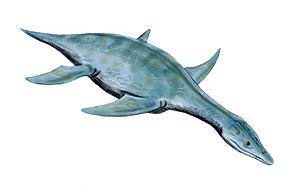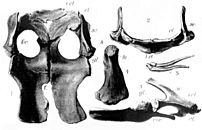Leptocleidus facts for kids
Quick facts for kids Leptocleidus |
|
|---|---|
 |
|
| Leptocleidus capensis | |
| Scientific classification |
|
| Kingdom: | Animalia |
| Phylum: | Chordata |
| Class: | Reptilia |
| Superorder: | †Sauropterygia |
| Order: | †Plesiosauria |
| Family: | †Leptocleididae |
| Genus: | †Leptocleidus Andrews, 1922 |
| Species | |
|
|
| Synonyms | |
|
|
Leptocleidus was a type of plesiosaur, a large, extinct marine reptile. It belonged to a family called Leptocleididae. These amazing creatures lived a long, long time ago, during the Early Cretaceous period.
Contents
What's in a Name?
The name Leptocleidus means 'slender clavicle'. It comes from two Greek words. λεπτοσ means "slender," and κλειδ (or κλεισ) means clavicle. The clavicle is a bone, like your collarbone.
What Did Leptocleidus Look Like?
Leptocleidus had a unique body shape. It had large clavicles and a big bone called an interclavicle. Its shoulder blades, called scapulae, were small. This made it look a bit like Rhomaleosaurus, another ancient marine reptile.
This creature had many teeth. It had 21 teeth on each side of its upper jaw (maxilla). It also had about 35 teeth on each side of its lower jaw (mandible). Its skull was shaped like a triangle. A small crest ran along the top of its head.
Unlike some other plesiosaurs, Leptocleidus had special cervical ribs. These were single-headed. It also had a deep dip in the bones of its neck vertebrae.
Leptocleidus was usually about 3 meters (10 feet) long. That's about the length of a small car! However, one species, Leptocleidus superstes, was much smaller. It was only about 1.5 meters (5 feet) long. This makes it the smallest known species of Leptocleidus.
Where Did Leptocleidus Live?
Most plesiosaurs lived in the open ocean. But Leptocleidus was different. It preferred shallow lagoons. It might have even visited brackish (slightly salty) and fresh water areas. These could have been places like the mouths of large rivers.
Scientists think Leptocleidus moved into fresh water to escape bigger plesiosaurs. This idea was suggested by a scientist named Arthur Richard Ivor Cruickshank.
Most Leptocleidus fossils have been found in The British Isles. But one species, L. capensis, was found in Cape Province, South Africa.
Different Species of Leptocleidus
Scientists have found a few different types, or species, of Leptocleidus:
- L. capensis was found in the Sundays River Formation in South Africa. These fossils are from the Valanginian age.
- L. clemai was found near Kalbarri in Western Australia. These fossils are from the Hauterivian-Barremian age.
- L. superstes was found in the Upper Weald Clay in Sussex, England. These fossils are from the Barremian age.
In 1995, a fossil was found on the Isle of Wight. It was first thought to be a Leptocleidus species. But in 2012, scientists decided it was a new type of plesiosaur. They named it Vectocleidus.
Images for kids
See also
 In Spanish: Leptocleidus para niños
In Spanish: Leptocleidus para niños





